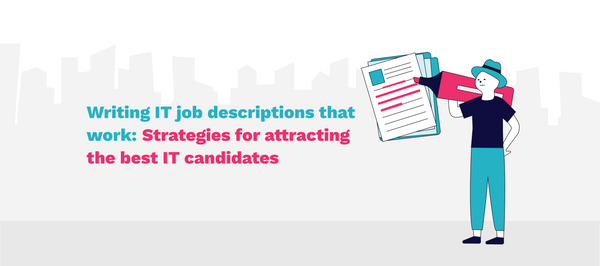How to Set Up a Reliable Tech Hiring Process for Your Company: 10 Tips
All companies struggle with hiring the right hands (and minds) from time to time. But the challenge is particularly hard for the tech industry, where the demand is high and the supply… well, leaves much to be desired. So, if you’re serious about recruiting qualified candidates for your vacancy, you need to have a well-laid-out hiring process in place.
Being an outsource recruitment partner for multiple tech companies, we’re here to share the hiring process steps we take when searching for candidates. You’re more than welcome to adopt them in your tech company as they’re sure to improve your hiring process, keep you organized and focused.
What is a tech hiring process?
A tech hiring process basically includes all the measures taken and stages involved in choosing the right candidates to fill vacant tech positions. This process may look different for every company depending on their specific needs, but it generally includes essential steps like gathering relevant information, interviewing candidates, screening and hiring them.
When it comes to the hiring process, there are two ways you can go: do it in-house or outsource the employee hiring process to IT recruitment agency. If you go for the second option, the whole process will be taken care of by the agency. But if you decide to handle staffing in-house, these ten steps will be an excellent roadmap for your tech recruitment journey.
#1: Define your hiring needs and write an effective job description
First things first. You have to clarify the information you need to know before searching for a candidate (the workload, team size, salary, certifications, qualifications, experience, benefits, etc.). At this stage, it's important to answer the following questions:
- Why do we need to hire a person for this position?
- What are the primary responsibilities of this position?
- What qualifications, requirements, and additional preferences are necessary for the position?
- Do we currently have the budget required for a qualified hire (add recruitment expenses, employee salary, paid leaves, additional benefits, incentives, etc.)?
Answering these questions will give you a deeper understanding of your staffing needs and information for the job description. Speaking of which, the job description has to be as detailed as possible to attract the most qualified candidates for the position.
Pro tip: Stand out from competitors by adding a unique benefit to working in your company or this position.
#2: Advertise and recruit for the position
When your job description is ready, determine the advertising channels and methods for the position. Google ads are a very popular means of advertising, but social media can also do wonders for distribution. So, make sure to advertise your vacancy on LinkedIn and Facebook (dropping the link in professional groups, recruitment groups, and job boards such as Jooble is never a bad idea). Just be sure to make your social media posts engaging and your Google ad creative.

When it comes to technical recruiting, remember: the best candidates don’t apply; they are found. Consider looking for them on industry-specific platforms like Stack Overflow, GitHub Jobs, dev.to, and others. Development communities and technical recruitment platforms like YouTeam are other sources for qualified candidates. And, of course, don’t think you’ll be able to skip manually headhunting potential employees on LinkedIn.
Pro tip: Referral bonuses are an excellent way to increase ad reach and interest in your position.
#3: Analyze and review candidate resumes
At this stage, you must have received applications from dozens of candidates. Take your time to vet their entries by carefully checking if they meet the minimum requirements for the position and your company.
While time-consuming, this process will help you weed out the ones that aren’t a fit and shortlist the candidates who have a fair chance at handling the responsibilities that come with the job.
#4: Screen and evaluate candidates
Now that you have a list of your pre-selected candidates, it’s time to contact them via their preferred channels (email, phone call, LinkedIn messaging, Facebook messaging, etc.). This pre-screening process will let you in on the candidate’s English level, communication skills, familiarity with the subject, overall knowledge, and availability for the position.
For an effective pre-screening interview, ask open-ended questions. They should be about:
- General things (What accomplishment are you most proud of?)
- Experiences and background (What are your strengths and weaknesses?)
- Job-specific questions (Why did you decide to work with this particular technology?)
Pro tip: Make the applicant feel comfortable by starting with personal, friendly questions.
#5: Carry out a technical assessment
Since you're recruiting a person for a tech position, it’s essential to give the candidate’s technical skills a test. Along with the tech skills, this assessment can demonstrate the person’s logic and the way they think.
The technical task should be carefully designed to reflect the issues the candidate will be dealing with if they get hired. Choose issues that have several solutions: some more optimal than others. The solution the applicant chooses has a lot to tell about the person.
The assessment can come in the form of a coding test, a take-home assignment, technical interview questions, or a live coding session.
#6: Run a background check
At this stage, you must have narrowed down your numbers to a few highly qualified candidates. It’s time to run background checks on them, contacting their previous employers and colleagues. This will give you third-party insights into a candidate's work relationships, previous responsibilities, good and bad traits.

#7: Make the hiring decision
If by this stage you have one candidate left, you’re in luck. But often, you’ll find yourself torn between two or more highly-qualified candidates to choose from.
To make the final choice, you can test their non-technical skills like time management, project management, and communication. Alternatively, you can carefully go through the previous stages for each individual again, especially the screening, technical assessment, and background check. Someone is sure to stand out.
Pro tip: Have a back-up candidate you can always reach if things don't work out with your top choice.
#8: Make a job offer
It's finally time to tell the most successful candidate the good news. You can do this by sending an initial congratulatory message via email and an official offer letter afterward. The job offer should include the candidate's start day, salary, benefits, paid time off, severance pay, remote working policy, and other terms and conditions of employment.
#9: Finalize the hiring process
You’re on the finish line. All you have to do to finalize the recruitment process is fill in various forms and sign documents with your newest employee.

#10: Start the onboarding process
Congratulations to both of you! Now, the newly hired employee needs to be properly integrated into the company and the team. You should help them learn more about the company’s history, culture, and general structure, introduce them to their new teammates, maybe even meet the founders for a personal touch and a sense of importance.
The bottom line
Setting up a tech hiring process can be stressful and time-consuming. Hopefully, following our ten tips will make recruiting the right candidate a tad easier.
But if you’d rather have someone go through this process for you, we know just the recruitment agency. MagicHire’s professional English-speaking tech recruiters are glad to help you at every stage of the hiring process. Regardless if you’d like to outsource all stages of the recruitment process or just some of them (analyzing CVs, background checks, pre-screening interviews), we’re here to help. So, contact MagicHire today!






